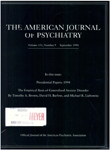Suicidal behaviors in adult psychiatric outpatients, I: Description and prevalence
Abstract
OBJECTIVE: Because the findings of previous studies of suicidal behaviors in psychiatric outpatients may not necessarily generalize to outpatients with a wide spectrum of psychiatric diagnoses, the authors evaluated the prevalence of suicidal behaviors in a large general psychiatric outpatient clinic whose patients represented a full spectrum of psychiatric illness. METHOD: A total of 651 patients participated in the study between 1987 and 1989. These patients had sought treatment at the outpatient psychiatry department of a private nonprofit hospital. Before being interviewed for treatment, all patients were given a comprehensive self-rating survey packet that included the Harkavy Asnis Suicide Survey and the Hopkins Symptom Checklist-90. The Harkavy Asnis Suicide Survey is a self-report questionnaire that assesses demographic variables, current and past history of suicidal behaviors of the patient as well as family members and peers, and a detailed description of each previous attempt. RESULTS: Fifty-five percent of the patients had a history of suicidal ideation, and 25% reported at least one previous suicide attempt. Approximately half of the suicide attempters reported multiple attempts. The predominant methods of attempt were overdose (53%), jumping (17%), and wrist cutting (17%). Suicidal behavior was prevalent in most diagnostic groups. The rates of suicidal ideation among patients with mood disorders (major depression, dysthymia, and bipolar disorder), adjustment disorders, and alcohol/substance abuse were significantly greater than that of the patients with generalized anxiety disorder. CONCLUSIONS: The authors conclude that suicidal behavior is prevalent among patients who seek treatment in a general outpatient department.
Access content
To read the fulltext, please use one of the options below to sign in or purchase access.- Personal login
- Institutional Login
- Sign in via OpenAthens
- Register for access
-
Please login/register if you wish to pair your device and check access availability.
Not a subscriber?
PsychiatryOnline subscription options offer access to the DSM-5 library, books, journals, CME, and patient resources. This all-in-one virtual library provides psychiatrists and mental health professionals with key resources for diagnosis, treatment, research, and professional development.
Need more help? PsychiatryOnline Customer Service may be reached by emailing [email protected] or by calling 800-368-5777 (in the U.S.) or 703-907-7322 (outside the U.S.).



